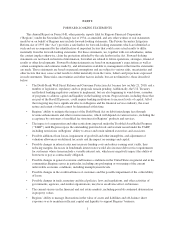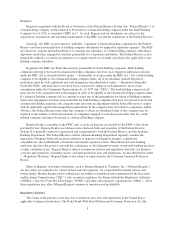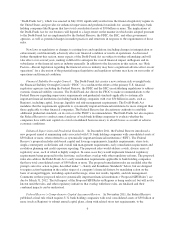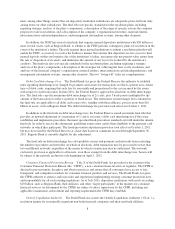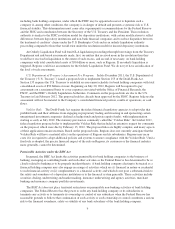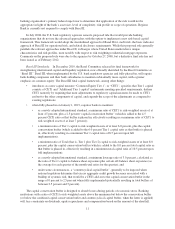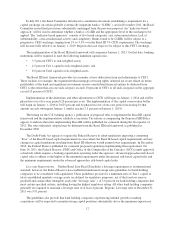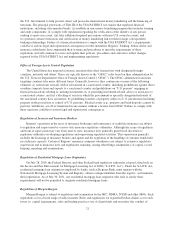Regions Bank 2011 Annual Report Download - page 35
Download and view the complete annual report
Please find page 35 of the 2011 Regions Bank annual report below. You can navigate through the pages in the report by either clicking on the pages listed below, or by using the keyword search tool below to find specific information within the annual report.banking organization’s primary federal supervisor to determine that application of the rule would not be
appropriate in light of the bank’s asset size, level of complexity, risk profile or scope of operations. Regions
Bank is currently not required to comply with Basel II.
In July 2008, the U.S. bank regulatory agencies issued a proposed rule that would provide banking
organizations that do not use the advanced approaches with the option to implement a new risk-based capital
framework. This framework would adopt the standardized approach of Basel II for credit risk, the basic indicator
approach of Basel II for operational risk, and related disclosure requirements. While this proposed rule generally
parallels the relevant approaches under Basel II, it diverges where United States markets have unique
characteristics and risk profiles, most notably with respect to risk weighting residential mortgage exposures.
Comments on the proposed rule were due to the agencies by October 27, 2008, but a definitive final rule has not
been issued as of February 2012.
Basel III Standards. In December 2010, the Basel Committee released its final framework for
strengthening international capital and liquidity regulation, now officially identified by the Basel Committee as
“Basel III.” Basel III, when implemented by the U.S. bank regulatory agencies and fully phased-in, will require
bank holding companies and their bank subsidiaries to maintain substantially more capital, with a greater
emphasis on common equity. The Basel III final capital framework, among other things:
• introduces as a new capital measure “Common Equity Tier 1”,or “CET1”, specifies that Tier 1 capital
consists of CET1 and “Additional Tier 1 capital” instruments meeting specified requirements, defines
CET1 narrowly by requiring that most adjustments to regulatory capital measures be made to CET1
and not to the other components of capital, and expands the scope of the adjustments as compared to
existing regulations;
• when fully phased in on January 1, 2019, requires banks to maintain:
• as a newly adopted international standard, a minimum ratio of CET1 to risk-weighted assets of at
least 4.5 percent, plus a 2.5 percent “capital conservation buffer” (which is added to the 4.5
percent CET1 ratio as that buffer is phased in, effectively resulting in a minimum ratio of CET1 to
risk-weighted assets of at least 7 percent);
• a minimum ratio of Tier 1 capital to risk-weighted assets of at least 6.0 percent, plus the capital
conservation buffer (which is added to the 6.0 percent Tier 1 capital ratio as that buffer is phased
in, effectively resulting in a minimum Tier 1 capital ratio of 8.5 percent upon full
implementation);
• a minimum ratio of Total (that is, Tier 1 plus Tier 2) capital to risk-weighted assets of at least 8.0
percent, plus the capital conservation buffer (which is added to the 8.0 percent total capital ratio as
that buffer is phased in, effectively resulting in a minimum total capital ratio of 10.5 percent upon
full implementation);
• as a newly adopted international standard, a minimum leverage ratio of 3.0 percent, calculated as
the ratio of Tier 1 capital to balance sheet exposures plus certain off-balance sheet exposures (as
the average for each quarter of the month-end ratios for the quarter); and
• under some circumstances, a “countercyclical capital buffer”, generally to be imposed when
national regulators determine that excess aggregate credit growth becomes associated with a
buildup of systemic risk, that would be a CET1 add-on to the capital conservation buffer in the
range of 0 percent to 2.5 percent when fully implemented (potentially resulting in total buffers of
between 2.5 percent and 5 percent).
The capital conservation buffer is designed to absorb losses during periods of economic stress. Banking
institutions with a ratio of CET1 to risk-weighted assets above the minimum but below the conservation buffer
(or below the combined capital conservation buffer and countercyclical capital buffer, when the latter is applied)
will face constraints on dividends, equity repurchases and compensation based on the amount of the shortfall.
11


